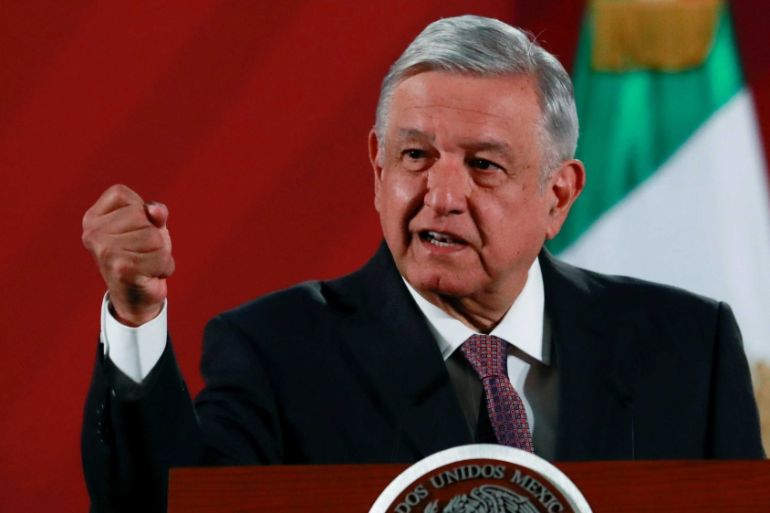Mexico announces ‘new normality’ in plan to reopen economy
More than 38,000 people have been infected with COVID-19 in Mexico, but health experts warn the number is much higher.

Mexican President Andres Manuel Lopez Obrador has unveiled a plan to reopen the country’s economy by June 1 as part of a “new normality” after several weeks of lockdown measures to curb the spread of the coronavirus pandemic.
Lopez Obrador said on Wednesday the reopening of economic, social and educational activities would be “cautious and gradual”, beginning with regions of the country least affected by the disease. The plan includes a “traffic light” coding system that will inform the public in different states which businesses and activities are safe to resume.
Keep reading
list of 3 itemsMexico’s government under pressure over coronavirus response
Four dead in shooting near Mexico’s presidential residence
Lopez Obrador’s announcement came less than 24 hours after the country reported its deadliest day during the pandemic, with 353 deaths recorded on Tuesday.
More than 38,000 people have been infected with COVID-19 in Mexico, and at least 3,926 have died, according to official figures. But experts say the true numbers are likely much higher, as the country has not collected sufficient data on the disease nationwide, and has not put in place effective mitigation measures – making plans to reopen in the coming weeks potentially dangerous.
“With this crisis, Mexico has been essentially flying blind,” said Tony Payan, director of the Center for the United States and Mexico at the Baker Institute.
“Mexico just doesn’t know the rate of progression of the disease, it doesn’t know how many cases there are, it doesn’t know how it’s been evolving,” Payan told Al Jazeera.

Mexico has conducted 0.9 COVID-19 tests per 1,000 people, the lowest among Organisation for Economic Co-operation and Development (OECD) countries.
Christopher Wilson, deputy director at the Mexico Institute of the Wilson Center, says the lack of data is a result of an ineffective “testing model” that Mexico has put in place, rather than too few tests, whereby the goal of any testing model is to provide officials with an overall sense of trajectories in different places around the country to enable leaders to make decisions.
“Their model for testing is designed to highlight basic trends without providing an accurate measure of the intensity of the pandemic in different places in Mexico,” Wilson told Al Jazeera. “The magnitude of the crisis in the hardest-hit areas of Mexico is huge and much more intense than what is being reported by the government officially,” he said.
Despite insufficient data, Deputy Minister of Health Hugo Lopez-Gatell announced on May 5 that Mexico had flattened the epidemic curve.
“Mexico was doubling the number of cases every five days, which is occurring every six days now,” Lopez-Gatell said during his daily coronavirus evening news conference, “so it is possible to say that the curve is flattening in the country.”
He added that the government’s “healthy distance” measures which encouraged citizens to stay at home, wear a mask in public and practise hygiene, had decreased cases by 60 to 75 percent.

Health experts, however, have questioned the government’s findings.
“Their projections are very bad mathematics and they are very ambitious,” said Laurie Ann Ximenez-Fyvie, head of the Laboratory of Molecular Genetics at Mexico’s National Autonomous University. “They are based on what they wish was happening, not only actual data.”
“It’s not alarmist to say that we are in a really tough spot,” Ximenez-Fyvie told Al Jazeera.
Health experts also warn that the widespread presence of pre-existing medical conditions among Mexicans puts people at a higher risk to the virus.
About a third of Mexican adults are classified as obese, while some 16 percent suffer from diabetes and more than 30 percent have hypertension – three chronic diseases that make people more vulnerable to complications from the virus.
AMLO focused on economics
Lopez Obrador’s government has faced intense criticism for being slow to respond to the crisis and refusing to impose the strict lockdown measures that neighbouring countries have put in place, such as closing down borders and limiting domestic travel.
In the sprawling capital Mexico City, where cases have surged, the crowded transport system continued to operate, and much of commercial life, such as open markets and street food, remained open.
Lopez Obrador, who is known by his acronym AMLO and once said the disease is “not even as bad as the flu”, has argued that he wished to avoid the economic fallout associated with the lockdowns, which would disproportionately affect the country’s poor, his base.

The consequences are especially dire for Mexico where 56 percent of workers are employed in the informal economy and where there are no federal unemployment benefits.
But as Lopez Obrador, like many leaders around the world, struggles to lay out plans to reopen the country, health experts concede that balancing the trade-off between limiting economic damage and saving lives, is no easy task.
“The number of confirmed cases is only one piece of the puzzle,” said Fernando Alarid Escudero an assistant professor at the Center for Research and Teaching in Economics (CIDE) in Mexico, who developed a model in collaboration with scientists at Stanford University to chart the curve of the epidemic in Mexico.
“The other pieces are economic, social and mental health costs,” he told Al Jazeera. “Decision-makers should come up with a strategy that comes up with the highest benefit at the lowest cost. That would be the ideal.”